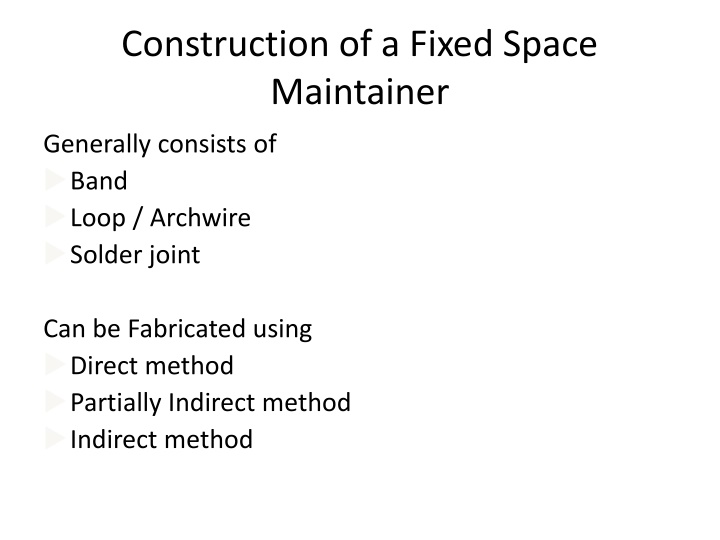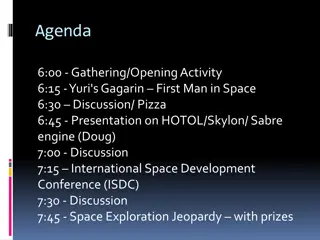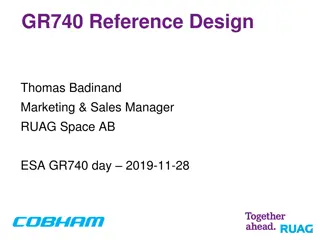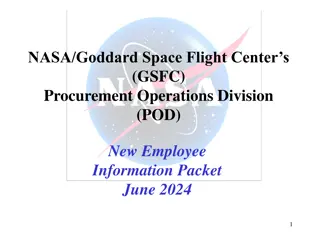
Band Formation and Space Maintainer Construction Guide
Learn about the construction of fixed space maintainers, including band formation, band pinching, and adaptation techniques. Explore the steps involved in creating bands for various appliances using direct and indirect methods. See images illustrating the extent of band placement on different sides of the tooth and detailed armamentarium required for the process.
Download Presentation

Please find below an Image/Link to download the presentation.
The content on the website is provided AS IS for your information and personal use only. It may not be sold, licensed, or shared on other websites without obtaining consent from the author. If you encounter any issues during the download, it is possible that the publisher has removed the file from their server.
You are allowed to download the files provided on this website for personal or commercial use, subject to the condition that they are used lawfully. All files are the property of their respective owners.
The content on the website is provided AS IS for your information and personal use only. It may not be sold, licensed, or shared on other websites without obtaining consent from the author.
E N D
Presentation Transcript
Construction of a Fixed Space Maintainer Generally consists of Band Loop / Archwire Solder joint Can be Fabricated using Direct method Partially Indirect method Indirect method
Band Important part of various appliances Can be made of precious metal, chrome alloys May be Preformed or Tailor Made Preformed available in various sizes for each tooth Band material available in sizes of 0.125 0.003 Anteriors 0.150 0.004 Bicuspids 0.180 0.005 Deciduous Molars 0.180 0.006 Permanent Molars
Steps in Band Formation Separation Band Pinching & Adaptation Welding Trimming & Polishing
Separation of teeth Brass Wire 0.015 0.020 inch soft wire Elastics Usually kept for 24 - 48 hours
Band Formation For tailor made bands ! Direct Method Using How / Hoe Pliers Using Band Forming Pliers Peak Pliers Howlett Pliers Indirect Method
Extent of Band Buccally below level of buccal developmental grooves and not in contact with opposing tooth. Lingually below level of lingual groove Proximally above contact area but below marginal ridge. Gingivally Should extend around 0.5 mm inside sulcus. Follow gingival contour. No Blanching of gingiva
Band Pinching 2 inch strip of band material cut from spool Contoured using Johnson s contouring pliers. Not needed if band forming pliers used Ends of strip welded to form loop Depending on pliers being used - inserted onto plier or tooth. Bands pinched on lingual side. Should be very closely adapted to tooth.
Band is Spot welded in 3-4 areas. Excess band material cut off 3-4 mm away from seam Tag folded mesially, spot welded in 3-4 areas Festooning done Trimming done to adjust height Trimmed, Polished.
Formation of Loop / Archwire This is done according to the type of Space Maintainer being fabricated.
Soldering Refers to the joining of two metals by melting and flowing another metal between them at a temperature below the solidus temp. of either of the metals being joined. Types free hand, investment soldering
Finishing & Polishing Space Maintainer trimmed using Heatless stone Space Maintainerooth edges required Polished using Rubber Wheel
Band & Loop Space Maintainer Fixed Unilateral Type Used in Posterior segments E.g. Maintain space of 1st Deciduous Molar before eruption of 1st premolar
Technique of Construction: Band & Loop Space Maintainer Select a band / Adapt a band to tooth posterior to lost tooth Place band on tooth Make an impression using Alginate Remove band, seat in impression, stabilize it Pour the cast Adapt U loop on cast 19 G, round SS wire Stabilize U loop with dental plaster Solder, finish & polish Cementation of Space Maintainer
Lingual Arch Space Maintainer Fixed Bilateral Space Maintainer Used in lower arch Can Prevent Lingual tipping of teeth as well as A-P movement Used only after eruption of permanent incisors. Otherwise Band & loop Space Maintainer used. Modifications: with canine spurs, removable with precision molar tubes, with U loops Wire should be passive
Advantages of Lingual Arch Space Maintainer Holds molar position distally and the incisors labially Prevents incisor collapse Preserves canine space, e.g. in serial extraction.
Nance Palatal Arch Also called Nance Holding Arch Used in upper arch Used when there is bilateral loss of primary posterior teeth
Disadvantages of Nance Palatal Arch Space Maintainer Soft Tissue irritation Palatal tissue hypertrophy if oral hygiene not maintained.
Distal Shoe Space Maintainer Also called Willets Guiding Shoe Appliance, Intra-alveolar App. Used when there is premature loss of E before eruption of 6 Main objective is to guide the erupting 6 to its correct position.
Complications of Distal Shoe Space Maintainer Difficult to construct accurate appliance Acts as a foreign body Need for periodic evaluation for correct positioning Possible breakage and subsequent trauma
Contraindications of Distal Shoe Space Maintainer Several missing teeth, lack of abutment. Certain medical conditions like Rheumatic heart disease, blood disorder. conditions, use a removable app. to apply pressure on ridge just mesial to 6 ; OR Regain space later on. In these
Band & Bar Type Space Maintainer Fixed type of Space Maintainer Teeth on either side of space are banded. A Bar is soldered on to these. Is the simplest type of Functional Space Maintainer
Trans Palatal Arch Space Maintainer Used to maintain space when there is individual / bilateral loss of maxillary primary molars Bands adapted onto molar on each side Working model prepared A 19 gauge wire adapted along palatal surface avoiding contact with soft tissue Soldering, finishing and polishing done.
Bonded Type of Space Maintainer Easy to prepare type of Space Maintainer Brackets bonded onto tooth on either side of space Arch wire ligated.
Open Coil Space Regainer Active Space maintainer. Similar to Band & Loop Space Maintainer, but the loops are Parallel, are inserted into buccal tubes, and the loop has a spring around it Spring pushes loop out of buccal tube and thus regains space
Recall and Maintenance of Space Maintainer All Space Maintainer Patients have to be under recall program Removable Space Maintainer have to be checked to see their fit, checked to see if they hamper growth Fixed Space Maintainer have to be removed every 3-4 months and checked for DC and then re-cemented. GIC recommended for cementation. If any primary tooth anchoring Space Maintainer is shedding off, then another suitable Space Maintainer has to be

![Read⚡ebook✔[PDF] Linking the Space Shuttle and Space Stations: Early Docking Te](/thumb/21519/read-ebook-pdf-linking-the-space-shuttle-and-space-stations-early-docking-te.jpg)
![READ⚡[PDF]✔ Emerging Space Powers: The New Space Programs of Asia, the Middle Ea](/thumb/21554/read-pdf-emerging-space-powers-the-new-space-programs-of-asia-the-middle-ea.jpg)


















